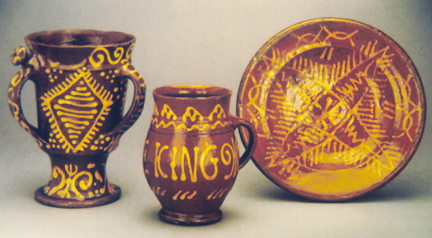
Metropolitan Ware, Earthenware with slip decoration, English, 1600 CE
ART 198 - HISTORY OF WORLD CERAMICS
| Inspired by the use of slip trailing in German salt glazed wares, English potters at Harlow began using slip trailing as a decorative technique for pottery intended for the London market. A cream colored slip was trailed onto a dark terra cotta body to create patterns and text, such as the three pieces at right. Pattern was more common than text, and when the pots did carry text messages, they were often admonishments such as 'Fear God,' or Obeay the King,' or 'Fast and Pray.' These sentiments reflect the strong Puritan movement of the time. Slip trailing involves filling a rubber syringe (like an ear syringe) with the smooth slip. Then by gently squeezing the bulb as the tip of the syringe is drawn across the clay surface, a raised line of slip is deposited on the ware. The slip will dry and shrink along with the piece and retain its raised line quality after firing. Ware was simply glazed with a clear lead glaze. It was not until the 1880's that lead glazing was banned on food surfaces. | Metropolitan Ware, Earthenware with slip decoration, English, 1600 CE |
|
|